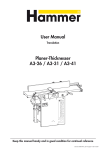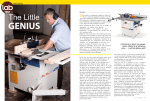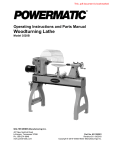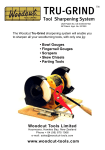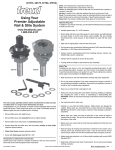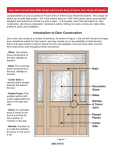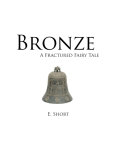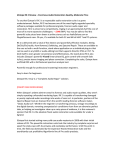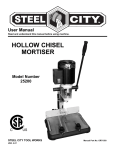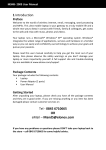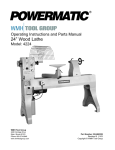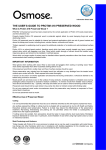Download Hammer A3-41 Planer and Thicknesser Review
Transcript
PHOTOGRAPHS COURTESY OF PETER SEFTON AND FELDER UK Hammer’s A3-41A Surface Planer and A3-41D Thicknesser Peter Sefton tests the new Hammer A3-41A Surface Planer and A3-41D Thicknesser I have just been down to Felder UK’s headquarters in Milton Keynes to test the new Hammer A3-41A Surface Planer and the A3-41D Thicknesser, which are the first separate planers in the Hammer range as well as the only 410mm wide separates I have seen in this price bracket before. The two new planers are based on the A3-41 ‘under-over’ planer thicknesser that was launched last year as an updated version of the tried and tested model I have been using in my workshop for the past seven years. My planer has served me very well and I was interested to see how the new machines had been changed, improved or otherwise. 18 F&C193 A3-41A Surface Planer: the beds The A3-41A surfacer has heavy ribbed cast iron beds that are 1,800mm long and 410mm wide. The planer’s tables have a finely ground surface which are much better than others I have seen on the market. It obviously doesn’t match the Felder’s polished surface but is just as sturdy and now incorporates the same dual lifting tables, which are great to use and give easy access when changing the cutters. They are built in the same factory so I’m sure the general level of engineering is very similar, as they are coming off the same production line. The depth of cut is adjusted via a lever on the operator’s side of the A lever easily adjusts the infeed table with a 0-4mm scale www.woodworkersinstitute.com TESTS & EQUIPMENT Hammer A3-41A Surface Planer and A3-41D Thicknesser The robust bridge guard could have larger knobs but offers good protection The fence is attached to an extruded aluminium bar on the end of the infeed table infeed table, which adjusts the height of cut between 0-4mm using Felder’s own prism guide rail system. This is easier to use than the older style turn knob located on the back of the infeed table which my current model has. The depth of cut scale is located on the front of the infeed table casing, in 0.5mm increments. In practical use, this moved quite smoothly with the added bonus that the table did not need to be unlocked. The tables are factory set with a tolerance of between 0.2 and 0.5mm when edging a 2m long test sample. The outfeed table can be reset once on site after the machine has settled, and all is explained in a very comprehensive user manual which is supplied with each machine. The fence Cutter block Power and dust extraction The standard three knife cutter block is 72mm in diameter, using Hammer’s quick changeover disposable blades which are double-sided and usually take me about 10-15 minutes to replace – half this time is generally spent cleaning off the block with resin cleaner. The cutter block revolves at 5,000rpm and gives a very good surface finish. The machine’s cutter block can be fitted with an optional extra mortising chuck, sized up to 16mm, which can be used for cutting slot mortises on an optional moving table. I haven’t used this part of the machine so can’t comment on its performance but will say that my personal preference would be to use a floor mounted hollow chisel mortiser in the conventional way. I found the bridge guard a bit fiddly to adjust as the height adjusting knob was a little small for my liking but something I would soon replace with a larger one if it became an annoyance. Otherwise the guard was more than adequate for the job and of equal quality to others I have seen at similar price levels and above by Italian manufacturers. www.woodworkersinstitute.com The anodised aluminium fence is 150mm by 1,100mm long and is end mounted to the infeed table on an extruded aluminium section. It has extra support given at its midway point by a bracket also acting as the rear guard over the cutter block. Pleasingly, the fence is more rigid than it appears at first but personally I found the movement of it a little frustrating – having to undo the locking nuts in two places; my preference is the older style single mounting on the outfeed table. The fence can be adjusted between 90° and 45° on adjustable stops but does take up a larger space behind the machine than the more expensive Felder, which boasts a robust end mounted space saving fence design. The A3-41A comes in either a 5.5hp (4.0kW) three-phase or a 4hp (3kW) single phase version; both of which are powerful for both the size and price of machine. Dust extraction is via a 120mm port situated under the outfeed table and the machine comes with standard micro switches which isolate the machine when the dual tables are lifted. The machine stops within the 10 second regulation by friction and natural run down as opposed to electric braking. ➤ F&C verdict The obvious advantages of the separate machines are no changeover between planing and thicknessing and less wear and tear when moving the spring-loaded heavy tables. Of course when they are used in multi occupant workshops, two craftsmen can be working at the same time. Equally, separates can suit a single person workshop that has either enough floor space or just wants to be able to leave a particular machine set up. For anyone requiring a standalone surface planer this is a good option as it sits between the smaller, lighter Axminster and Jet models or the more expensive Griggio and SCMs which aren’t able to offer models in 240V. Pros Solid cast iron tables Quick change disposable cutters Powerful single phase option Only one on the market at this price point Cons Small adjusting knobs on the bridge guard Cumbersome fence adjustment The numbers Single phase 240V motor 4hp /3kW at 50Hz Three phase 5.5hp/4kW motor Beds 1,800 x 410mm Net weight 295kg Price £2,518.80 (inc VAT) The newly designed fence adjustment and rear bridge guard From www.ukhammer.co.uk F&C193 19 ➤ A3-41D Thicknesser The new Hammer Thicknesser that complements the A3-41A, is the A3-41D, sporting the distinctive red and grey 3mm thick steel casing that all the Hammer range has. The 410mm wide thicknesser is a sturdy 220kg and has a solid footing of 850mm long and 710mm wide at its base. It does need 860mm of width when the cutter hood is lifted for blade changing and maintenance. The thicknessing capacity is 404mm wide and a maximum depth of 225mm. The thinnest material is limited to 4mm but using a false base board I was able to thickness down to 2.4mm with some straight-grained cherry (Prunus spp.) to give a very clean finish from the three knife block. The bed The thicknesser bed rises on a heavy single column and can be locked in position for accuracy The heavy cast iron bed is 600mm long and can be fitted with bed extensions on the outfeed side; both are 150mm wide and can be either 400mm or 800mm long. They fit on a mounting bracket, which is also an optional extra. The bed rises and falls on a single central column and showed no sign of any movement during the test. If it performs as well as my A3-41 has, it should stay accurate for the long term. The height of the bed is adjusted by a hand wheel that is geared to raise the bed 2mm for every clockwise revolution and is shown on the imperial and metric rule bar located under the infeed side of the thicknessing table. The optional digital dial – available in either mm or inches – is a must for me, as it means I can accurately make adjustments The hood is held up with a gas strut and allows good access for blade changing whilst the micro switch offers protection for the user 20 F&C193 www.woodworkersinstitute.com TESTS & EQUIPMENT Hammer A3-41A Surface Planer and A3-41D Thicknesser The 120mm dust extraction port is out of the way around the back of the machine right down to 0.1mm. I would not be without this addition and other extras are available including the moving roller carriage – useful if you intend to move the machine around your workshop. The planer can also be moved with the insertion of four M10 by 50mm bolts that fit low down in pre-tapped holes in the machine’s base. This means the machine can be moved using a pallet truck which is pretty useful if you have one. Planed finish The machine is supplied with a 72mm diameter three knife block equipped with Hammer’s quick change disposable knives, which give a very good surface finish on most regular timbers. One advantage of having a separate thicknesser is that when planing interlocked or alternating grained timbers, you can change over to HSS knifes – an optional extra with new wedge bars – and grind or slipstone a back bevel on them to reduce the amount of break out. This isn’t advisable when using a surface planer, as the amount of cutter resistance and bounce a back bevel can cause when hand feeding timber can be dangerous. The feed speed of the A3-41D Thicknesser is set to 6m per minute, which I found gives a very good finish and is easy to handle when working alone. The feed rollers can be disengaged when the thicknesser is not in use and is advised in order to save wear on the drive belts. The machine brakes within 10 seconds to comply with regulations by means of friction on the drive wheels rather than electric brake as some machines do. This may well be shown to be a benefit over time as electric braking is one more thing that can go www.woodworkersinstitute.com wrong and I like Hammer’s thinking that sometimes it’s just best to keep things simple! The machine has anti kick-back fingers to prevent timber being ejected back towards the operator followed by a serrated solid steel infeed roller, which is set on springs to keep downward pressure on the timber being fed into the machine. A maximum of two pieces of timber can be fed into the machine alongside each other as long as they are no more than 1mm different in thickness to prevent the thinner piece being thrown back. The solid steel outfeed roller is lightly printed with a slight knurled effect to grip but did not mark the timber surface as it pulled the timber through. I noticed minimal heel or snipe being taken by the cutter block and a very good finish on my timber. The maximum depth of cut is 4mm per pass and I found it could take a minimum of 0.4mm before the infeed roller left any witness marks on the planed surface. Dust collection The extraction outlet is 120mm in diameter and is located on the back side of the machine. This is useful and well out of the way when passing timber through the machine and was effective at keeping the machine and timber surface clean. Switches The thicknesser has a good, flat surface on top of it which is great for putting short timbers on whilst waiting to be planed. Another couple of nice touches are the separated emergency ‘off’ switch situated on the outfeed side of the machine and the micro switch that isolates the machine when the hood is lifted for maintenance. F&C F&C verdict I think Hammer has made a very good 410mm thicknesser here, and the only one I can think of at this price. It looks like a winner and a deserving machine to carry the Hammer badge and I think it will pick up admirers from both serious amateurs and small production workshops. It has certainly caught my eye. Pros Solid cast iron bed with strong column Powerful single and three phase options Quality surface finish Cons None The numbers Single phase 240V motor 4hp /3kW Three phase 5.5hp/4kW motor 220kg net weight Thicknesser capacity 404 x 225mm Feed speed of 6 metres a minute Price £2,518.80 (inc VAT) From www.ukhammer.co.uk F&C193 21




